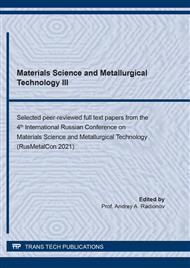[1]
J.A. Schey, Introduction to Manufacturing Processes, McGraw Hill, Boston, (2000).
Google Scholar
[2]
S. Boonmee, D.M. Stefanescu, Casting skin of compacted graphite iron. Part II: Influence on tensile mechanical properties, AFS Transactions. 118 (2010) 217-224.
Google Scholar
[3]
C. Labrecque, M. Gagne, P. Cabanne, C. Francois, C. Beret and F. Hoffmann, Comparative study of fatigue endurance limit for 4 and 6 mm thin wall ductile iron castings, International Journal of Metalcasting. 2 (2008) 7-17.
DOI: 10.1007/bf03355424
Google Scholar
[4]
M.S. Starkey, P.E. Irving, A comparison of the fatigue strength of machined and as-cast surfaces of SG iron, International Journal of Fatigue. 4(3) (1982) 129-136.
DOI: 10.1016/0142-1123(82)90039-1
Google Scholar
[5]
S. Boonmee, B. Gyesi, D.M. Stefanescu, Casting skin of compacted graphite iron. Part I: Evaluation and mechanism for formation, Trans. AFS. 118 (2010) 205-216.
Google Scholar
[6]
G. Alonso, D.M. Stefanescu, E.D. Fuente, P. Larranaga, R. Suarez, The influence of trace elements on the nature of the nuclei of the graphite in ductile iron, Journal Materials Science. 925 (2018) 78-85.
DOI: 10.4028/www.scientific.net/msf.925.78
Google Scholar
[7]
E. Fraś, M. Górny, H. Lopez, Eutectic cell, chilling tendency and chill in flake graphite cast iron, Part III: Thermal analysis, Transactions of American Foundry Society. 115 (2007) 476-480.
Google Scholar
[8]
D.M. Stefanescu, S.R. Giese, T.S. Piwonka and A. Lane, Cast iron penetration in sand molds, Part I: Physics of penetration defects and penetration model, AFS Trans. 104 (1996) 1233-1248.
DOI: 10.2172/432796
Google Scholar
[9]
J. Jezierski, B. Dariusz, Properties of cast iron modifying with use of new inoculants, Journal of Achievements of Materials and Manufacturing Engineering. 22(1) (2007) 25-28.
Google Scholar
[10]
F. Mampaey, D. Habets, J. Plessers, F. Seutens, On-line oxygen activity measurements to determine optimal graphite form during compacted graphite iron production, International Journal of Metalcasting. 4(2) (2010) 25-43.
DOI: 10.1007/bf03355464
Google Scholar
[11]
J. Jezierski and D. Bartocha, Properties of cast iron modifying with use of new inoculants, Journal of Achievements in Materials and Manufacturing Engineering. 22(1) (2007) 25-28.
Google Scholar
[12]
H.O. Reisener, Some aspects of the formation and structure of a skin on iron castings and a method used to obviate its occurrence, The British Foundryman. 55 (1962) 362-369.
Google Scholar
[13]
S. Matijasevic, J. Gomez-Gallardo and J.F. Wallace, Ferritic surface layers on gray iron castings, AFS Trans. (1974) 571-592.
Google Scholar
[14]
G.S. Narasimha Swamy and J.F. Wallace, Factors influencing the ferrictic layer on the surface of gray iron castings, AFS Trans. (1975) 531-550.
Google Scholar
[15]
E. Fras and M. Gorny, Inoculation effect of cast iron, Archives of Foundry Engineering. 12(4) (2012) 39-46.
Google Scholar


